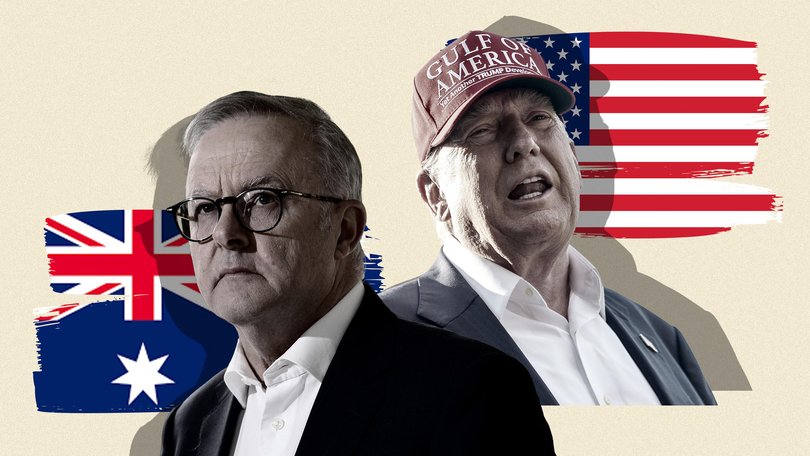Deadline Don’s trade pressure mounts as allies stare down the global tariff cliff

Deadline Don clearly has a thing for the 4th of July weekend.
From April 2’s Liberation Day to Independence Day, he wants his two signature policies, tax cuts and tariffs, off his desk in time to enjoy the fireworks.
On tax, the US Congress is still wrangling over its One Big Beautiful Bill. If passed, it will drop a bunker-buster tax bomb on the US budget worth $US3 trillion ($4.5t).
Sign up to The Nightly's newsletters.
Get the first look at the digital newspaper, curated daily stories and breaking headlines delivered to your inbox.
By continuing you agree to our Terms and Privacy Policy.Unfortunately for United States President Donald Trump, DOGE has failed to fire, incapable of rounding up any meaningful savings and jettisoning Elon Musk from the inner circle in the process.
Debt has never worried Mr Trump before, but even he can’t fight the bond market. With deficits set to soar, he needs his tariff policy to work.
In Mr Trump’s mind, tariffs are going to do the heavy lifting in terms of revenue.
But the anticipated “90 deals in 90 days” is currently 88 deals short of the July 8 deadline, meaning companies around the world are facing a mammoth jump in costs.
“It’s going to get really ugly, really fast,” said Jenny Gordon, former chief economist at DFAT and now a non-resident fellow at the Lowy Institute.
Among the few deals announced, Vietnam has been held up as a rare “win”. But even this so-called success comes at a cost.
Mr Trump’s agreement will impose a 20 per cent tariff on all Vietnam-made goods and a 40 per cent tariff on products transshipped through Vietnam from third countries, particularly China.
That’s double the 10 per cent placeholder tariff importers have been paying since April and only looks favourable in comparison to the 46 per cent wall they were bracing for. In return, American exporters get access to Vietnam tariff-free.
Score one to The Art of the Deal.
Even the stock market, always eager to chase good news, struggled to decide if the deal was worth cheering. Nike, heavily reliant on Vietnamese manufacturers, surged 4.1 per cent on the day after whipsawing in early trade. Lululemon and Deckers saw similar chart patterns. Nike has bounced back from its 15 per cent drop following April 2 levels, when the first wave of tariff panic wiped billions off their market caps. The other two have not recovered.
“Liberation Day was a bunch of ambitious claims designed to make countries grateful for being punished slightly less,” Dr Gordon said.
“But these tariffs are still new. They weren’t paying them before.”
At 12.01am US Eastern Standard Time on July 9, the full tariff matrix resets, with reciprocal rates ranging from 11 to 50 per cent snapping back into place for any country that hasn’t struck a formal agreement. That includes Australia, the EU, Japan, and others still deep in negotiations.
According to ING economists Inga Fechner and Carsten Brzeski, the US appears unlikely to grant many exemptions beyond countries that have either capitulated — like Canada, which scrapped its digital services tax — or offered strategic carrots, as China did with a rare earth export guarantee.
Even then, China still faces an effective tariff rate of 55 per cent and remains locked in multiple anti-dumping disputes.
“Protectionism is still the name of the game,” Ms Fechner and Mr Brzeski wrote.
“Despite trade talks, the US is not pursuing reciprocity. Tariff revenue is a strategic goal to finance at least part of the Big Beautiful Bill.”
The average US tariff rate now sits around 13 per cent and is expected to remain in the 12 to 15 per cent range. But for some nations, especially those caught between the US and China, the pressure is growing.
Mr Trump’s trade strategy, the ING economists warn, is increasingly pushing global supply chains to realign, forcing US allies to choose sides, particularly on digital trade, critical minerals, and technology transfers.
Australia is still waiting for clarity.
Penny Wong’s recent diplomatic visit to Washington yielded little, and Trade Minister Don Farrell’s overtures have yet to produce any formal deal.
“The view seemed to be: no special concessions for countries like Australia,” said Dr Gordon.
“If we hold the line on things like PBS and digital payments, we’re doing well. But I suspect we won’t avoid tariffs — maybe we’ll get the Britain equivalent of 25 per cent on steel and aluminium, but we’ll still wear 10 per cent elsewhere.”
She contrasted the UK’s “deal for the sake of a deal” with Australia’s lower status in Washington.
“The UK had something to offer, they put up King Charles, which appealed to Trump’s ego. And they were desperate to be able to announce something.
“By contrast, Australia isn’t going to be seen as a win. We tend to think we’re much more important than we actually are in the grand scheme of things.”
That left Canberra with limited leverage. “We do have bargaining chips, base access, AUKUS, critical minerals, but we can’t just keep selling the farm,” Dr Gordon said. “There’s no free lunch to be had on this.”
If America’s allies are feeling bruised, they’re not alone. Even long-standing partners are pushing back against Washington’s tariff demands — and being penalised for it.
Japan has refused to sign any deal that preserves Mr Trump’s 25 per cent automotive tariff, despite weeks of talks and seven visits to Washington by its economic team.
In response, the US has threatened further measures, including a cap on car exports — a throwback to 1980s-style voluntary restraints.
Mr Trump, never one to de-escalate, accused Japan of not buying American rice and suggested he’d soon be sending them a letter dictating their tariff obligations.
“Dear Mr Japan, you’re going to pay a 25 per cent tariff on your cars,” he said on Fox News.
“We give Japan no cars. They won’t take our cars.” He failed to appreciate that there is little room on Japanese roads F-150s.
Canada was also forced back to the table after Mr Trump doubled its steel tariffs with no warning. Only after Ottawa scrapped its digital services tax did negotiations resume. South Korea, meanwhile, is under pressure to curb Chinese transhipment and limit US tech regulation in return for tariff relief on autos and metals.
With just days to go, and conflicting messages from Mr Trump himself, it is hard to predict if the trade fireworks will see a finale or be a fizzer.
Even if Mr Trump gets what he wants and foreign companies (hint: it’s American consumers) start paying tariffs for access to the US market, the maths won’t stack up.
Modelling by Australian economist Warwick McKibbin, published by the Peterson Institute for International Economics, shows that under a high-tariff scenario with full retaliation and increased investor anxiety, the US would suffer sharp declines in growth and output.
In that scenario, US GDP falls 2.1 per cent by 2026, with durable goods production plunging nearly 12 per cent and agricultural output down 7 per cent.
Inflation spikes by 1.8 percentage points, forcing the Federal Reserve to tighten monetary policy even as real incomes fall.
Dr McKibbin predicts that a tariff 10 per cent, would result in a fall in tax revenue.
Dr Gordon compares it to Australia’s poorly thought-through cigarette tax.
“If you raise the taxes too high, ultimately you get less tax revenue out of it because you’ve reduced consumption.”

